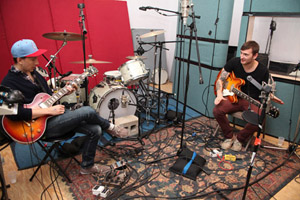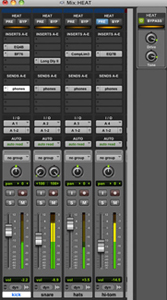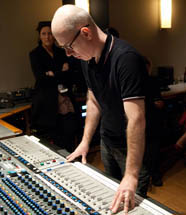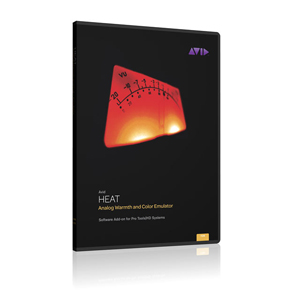Avid HEAT Reviewed by Geoff Sanoff
HEAT (Harmonically Enhanced Algorithm Technology) is Avid’s new software that runs within Pro Tools and adds tape and tube like saturation to all the audio tracks in a session.
It runs as a globally activated plug-in that is applied to all active audio tracks in a session (although it does not work on auxiliary, master fader or instrument tracks). The master controls consist of bypass, drive and tone. These do exactly what you think they do. On individual audio tracks the controls are equally scaled down, allowing you to bypass HEAT on a track and to set it as either pre or post insert. And that’s it.
The drive knob in the master section of HEAT is the primary control. Turning the knob to the left generates increasing amounts of third order harmonic content, emulating the sound of a tape machine. Turning it to the right adds second order harmonics to the third order saturation thereby emulating a tube stage along with the tape saturation.
The tone control allows you to brighten or darken the overall effect. Because it is a saturation effect, the ability to set it to be post or pre-insert on individual channels is important because this is the only way to alter the degree of saturation on a specific track.
HEAT IN ACTION: NEW CASSETTES & MAKER’S MARK RED WAX SESSIONS
I used this plug-in on two mix sessions recently and found it to be tremendously useful. The first of these was for British band New Cassettes. When they sent over their files for us to begin mixing, I noticed that they were 16 bit and overall rather hotly recorded.
The tracks all sounded good out of the gate, but it seemed like a perfect time to see what a program like HEAT could add to 16 bits. So after saving the sessions as 24 bit sessions, and adding a trim plug-in to knock down the overall levels a bit, I turned on HEAT and was immediately glad I did. It brought things to life in a way that made mixing this already well-arranged material that much easier.
Turning the HEAT drive knob to the left and right I discovered that I definitely preferred the more basic, third order harmonic settings. It was thicker and well…saturated. In general, I stayed within two or three clicks of the unity setting. And while the tone knob does adjust the overall tone (surprise!), in practice I never used it, preferring to use individual channel EQ’s to add or subtract top end as I felt was warranted.
[AVID Note: According to Pro Tools product manager Bobby Lombardi, “The tone control alters a number of algorithms and tables which affect how frequencies are being saturated and compressed. Moving the Tone control away from the center position will accentuate the amount of detail and brightness. The effect of raising the tone control is different, depending on which direction the Drive control is turned in. The amount and character of the harmonic content is changed by this control, in a non-linear fashion, unlike what a tone control in an EQ would do.”]
When mixing in the box, I tend to route all the tracks to a common bus and then print the mix to another track within the session, rather than bouncing to a file. Since HEAT doesn’t effect aux sends, if I wanted to print with HEAT on the mix, I had to use an audio track set to input as my master fader.
This wasn’t a big deal because these sessions were all at 44.1khz and they didn’t have heavy track counts, so sparing a track and the processing to run HEAT was no problem. But what was a little confusing at first was remembering to bypass HEAT on the track to which I was printing the mix. It was easy to forget to do this and I wanted to monitor the final mix as it would be when exporting the file from the session, not as it sounds with an additional amount of HEAT processing.
My primary observation about this plug-in (other than the silly name), is the monotheistic way it has been implemented. It’s very all or nothing. On one hand this is quite nice and leaves decision making to a minimum. Either you like it or you don’t. The gradations between settings are very minimal as well. You get a total of 5 detented settings in either direction of the drive knob. It’s tricky to tell whether it actually sounds better with it on, however, because the minute you engage it and begin to play with it, everything gets louder. This does not happen by leaps and bounds, but in subtler, non-linear ways inherent to a saturation type effect.
Since our ears tend to perceive louder sources as sounding “better,” comparing the effect of HEAT bypassed versus engaged is awkward. You turn it on and it gets a little louder so of course you think, “Wow, that sounds better!” But does it? It’s pretty easy to overdo it with brickwall limiters, and I was nervous that HEAT, while much subtler, would be similarly easy to push too far without realizing I was overcooking the mix (sorry couldn’t resist!).
The only way I could manage to figure out how to compare HEAT engaged and bypassed was to set up an offset trim on the master fader, turning it on at the same time as I turned HEAT on, which is not a terribly accurate way to measure.
I don’t know that there is much of a workaround for this given that saturation by its nature does increase overall RMS levels. It would be nice to have some kind of global trim that knocks down the level a smidge, post HEAT processing, so that comparing its on and off states is easier to accomplish. That said, I didn’t find HEAT’s increase in level to be massive, and this wasn’t a huge sticking point for me, since I like how it sounds.
A word of caution on this point: because HEAT is implemented globally, turning, it on or off on a mix means that the mix changes across the board. Futz with it before you really get into mixing because it is reactive to the source material, and tones and balances change when you use it. You don’t want to be 85% of the way done with a mix only to turn HEAT on and find your mix is no longer working. The overall level increase and tonal shifts are cumulative so they will affect not only individual channels but also any bus compression/effects you may be using.

Brooklyn's Bear Hands recording for the Maker’s Mark Red Wax Sessions at Stratosphere. Photo by Diana Wong.
Moving on…the other project I used HEAT on was recorded at 88.1khz. This was mixing the Maker’s Mark Red Wax Sessions in which I recorded 8 bands in 8 hours and then tried to mix the resulting 30 odd songs as quickly as possible. Because this session was such a whirlwind, tape machines were completely out of the question. So it seemed like an opportunity to see how HEAT handled higher sample rates both in terms of sonics and processing power.
As any Pro Tools HD user knows, HD cards are some old-ass processors and don’t match the power of today’s computers. So TDM based processing on higher sample rate recordings sometimes needs to be carefully delegated.
HEAT does use up a noticeable amount of processing at higher sample rates, but on the HD3 system I was mixing on at Stratosphere Sound, this really didn’t become an issue for me because the track counts were low enough and the Mac was fast enough, that I could use RTAS plug-ins to make up the loss of TDM slots. But, I can see how this would be a problem on a larger session especially as bypassing HEAT on a track does not free up DSP. You have to use RTAS plug-ins to save the DSP (which then uses up a time slot) or print the tracks with effects and deactivate the plug-ins (or buy more HD cards.)
After using HEAT on the second mix session, I was sold on its sound. Again, I found that turning the drive knob to the left two or three clicks added the saturation I was looking for and made the drums and bass sit like I wanted them to without a lot of work. The second order harmonic generation is just a little pointier and brighter than I seem to like. I can see how others might prefer it, but to my ears, the purely third order harmonic setting is easier to work with.
I don’t know that it sounds 100% like tape, others can worry about that question, but it does sound good. It makes it sound like there is more of what you want to hear without going into distortion.
I’d go so far as to say the fact that it doesn’t work exactly like tape is a plus, since even on the hottest recordings I was dealing with, HEAT never saturated into crackling or brittle distortion. When driving HEAT harder, it just gets darker (when putting the drive knob to the left) and less defined, like tape. But unlike tape or tubes or a lot of saturation plug-ins, it doesn’t seem to get distorted in an ugly way. The tubesque, second order harmonic setting gets a little shriller when hit hard but I never noticed it crackling or crapping out.
Dave Hill and Avid seemed to have figured out precisely where the useful range of their plug-in lays, and stepped the controls accordingly. So while I would have liked a few more options, what they have given us in the way of controls is well thought out within an extremely useful range of settings.
My only other irritation with HEAT is that I don’t know why the folks at AVID would design it to be HD only. It’s damn annoying even if it was a technical necessity. The upside to this, I suppose, is it may keep me from overusing it and getting sick of it. But, at a time when so many good things get recorded in less than optimal situations, HEAT gives you the ability to reinvigorate tracks in an easy and pleasing manner. And I want to use that power for good wherever I work, not just on high end rigs where, arguably, it’s actually less important.
[AVID Note on why HEAT is HD-only at launch: “Dave Hill writes some pretty incredible code that is highly optimized in assembly language suited for the 56k DSPs on HD. Host/RTAS code was not only unavailable, but early experiments had shown that the host code could not optimized without compromise to signal integrity when compared to HD, and for these reasons the initial launch was maintained as HD only. Avid certainly recognizes that there will be demand for the HEAT process on the host, and more importantly that without it, true round-trip session interoperability will not be possible.”]
HEAT
AVID Pro Tools HD
$495.00
Visit http://www.avid.com/us/products/HEAT to purchase HEAT or get a free 30-day demo, and be sure to check out the video on “Generating Heat,” featuring co-developer Dave Hill.
Geoff Sanoff is a GRAMMY-winning NYC-based producer/engineer and musician who’s worked with Fountains of Wayne, A Camp, Obits, Blk Jks, Keith Urban, Michael Stipe and Green Day (among many others!). Contact Geoff through Dan Backhaus at Just Managing.
Please note: When you buy products through links on this page, we may earn an affiliate commission.










Rich Lamb
November 21, 2010 at 7:41 pm (14 years ago)Another great, informative perspective from Geoff Sanoff!